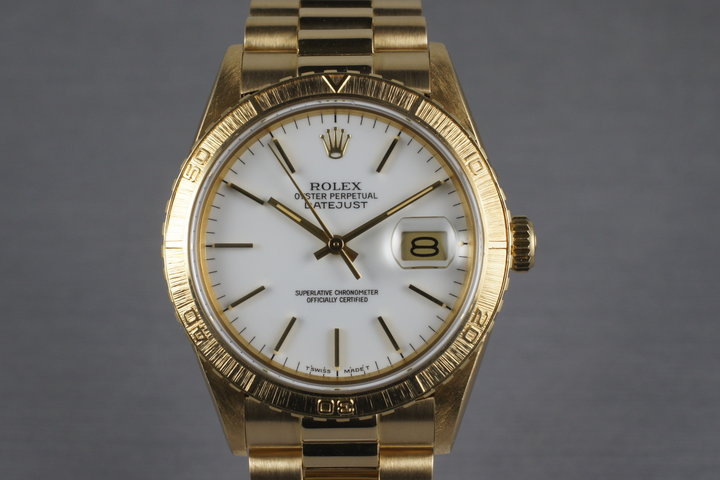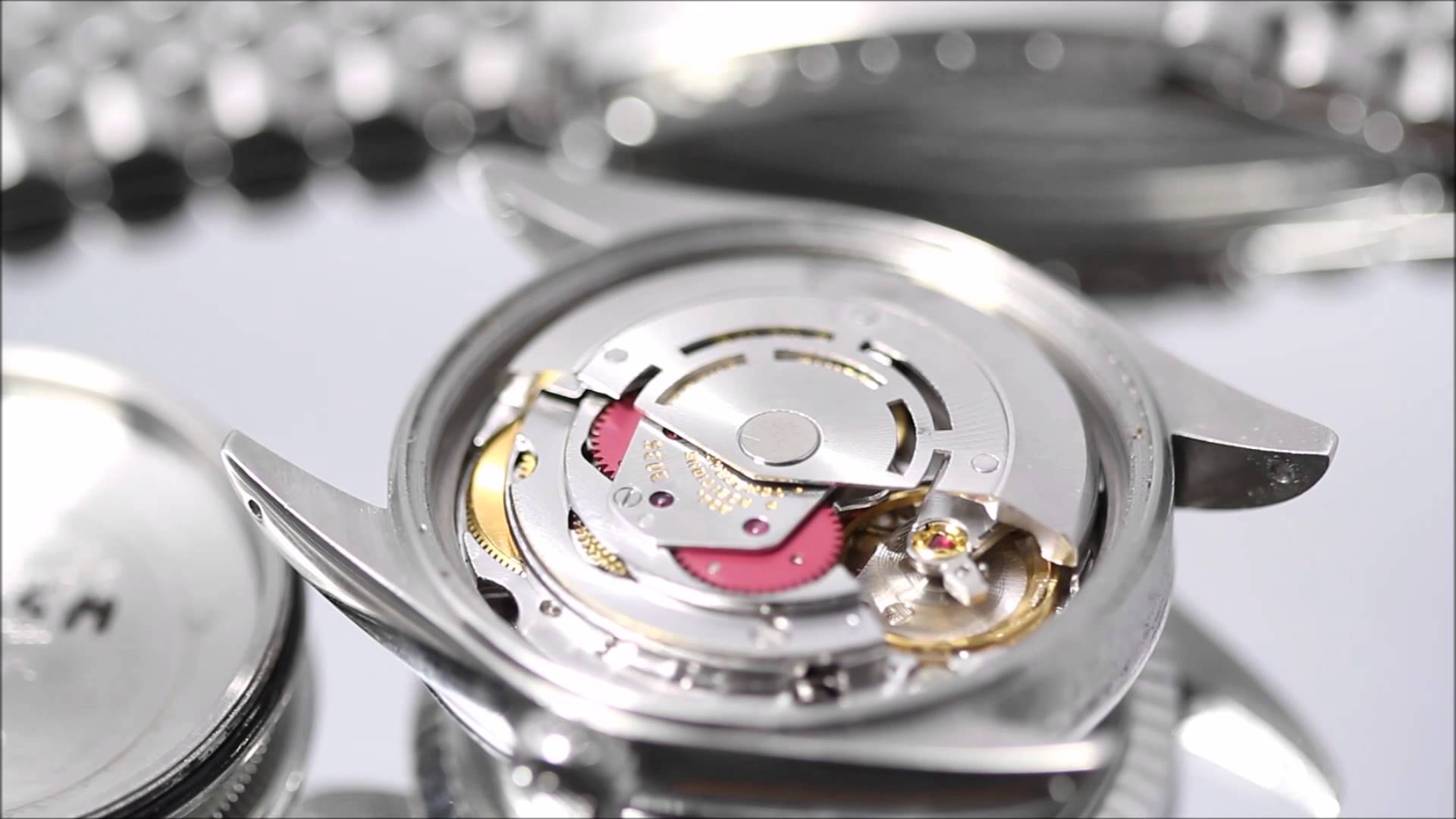Notes: The 16253 is a 36mm sold 18K gold Thunderbird from the 1980s. The case, bezel and bracelet are all made in 18 yellow gold. The band is typically an 18K yellow gold 3-link "president style" bracelet. The hour marks are typically index or roman. The dial faces can be champagne, black or white. The 18K yellow gold bezel is a rotating "Turn-o-Graph" with a barked finish and raised numbers.
Mechanism: The Rolex caliber 3035 was introduced in 1977 as what many refer to as a high-beat caliber 1575. In 1977, the Cal. 3035 ended the 12-year run of the 1570, it became the first men’s high-beat caliber Rolex had ever made. By increasing the balance speed from 19,800bph to 28,800bph, the new movement was able to offer an even greater level of accuracy and robustness than the already formidable abilities of its predecessor. The 3035 has a hacking capability.
It was this new speed on the 3035, causing the seconds hand to ‘tick’ eight times per second, that introduced the smooth sweep that is so characteristic of Rolex watches. Along with upping the movement’s frequency, which has since been adopted by every subsequent model Rolex has produced, the Cal. 3035 also led the field in another aspect; it was the first automatic caliber to feature a quickset function.
It was this new speed on the 3035, causing the seconds hand to ‘tick’ eight times per second, that introduced the smooth sweep that is so characteristic of Rolex watches. Along with upping the movement’s frequency, which has since been adopted by every subsequent model Rolex has produced, the Cal. 3035 also led the field in another aspect; it was the first automatic caliber to feature a quickset function.
Family Notes: The Datejust emerged in 1945, introducing the watch world to the innovative automatically changing date window. This feature made watch history and has since made the Datejust one of Rolex's most successful models. The ladies model that was introduced a few decades later has enjoyed a large amount of success as well, thanks to its functional yet luxurious design. The Rolex Datejust is the modern archetype of the classic watch, thanks to aesthetics and functions that transcend changes in fashion. Aesthetically, the Datejust has spanned eras, while retaining the enduring codes that make it, notably in its traditional versions, one of the most recognised and recognisable of watches.
Originally named the Jubilee Datejust, Rolex Datejust history began in 1945 when Rolex released the model for the company's 40th Anniversary. It was a direct descendant of the Bubbleback and included a date function, which was placed at the 3 o’clock position on the face. The Datejust had a coin-edge bezel, which later became the flutted bezel. It was the first watch to show the date automatically and also the first to change the displayed date at exactly midnight. The Datejust was innovative, unique, and different than any other watch offered at that time.
The history of Rolex Datejust begins with the first Datejust, the Jubilee Datejust Model 4467, which was only available in 18k gold and had a small bubbleback winder with a deeply domed back. In the 1950's, the Oysterdate joined the Datejust family, coming in two sizes. Although the Datejust originally consisted of three case parts, it was quickly updated to just two. Another major update was the addition of the Cyclops lens in 1954. Today this lens is standard to Rolex watches and even part of the brand’s signature. Before 1954, however, no one had used a magnifying bubble on the lens right above the date. Then, in 1957, a new, lighter, slimmer movement, the caliber 1065, allowed for a flattened case back in place of the old domed one. That same year, the Datejust became available in Steelium (stainless steel) in addition to the original gold. Other changes over the years included a flat dial (rather than curved) and the Rapid Date Change (aka quickset) feature.
The fact that Rolex Datejusts are still purchased and worn today is a testament to their enduring respectability and timelessness. To understand the Rolex Datejust history, pictures can be worth a thousand words. Seeing pictures of multiple presidents and other powerful people wearing the Rolex Datejust shows the importance and significance of this watch.
Originally named the Jubilee Datejust, Rolex Datejust history began in 1945 when Rolex released the model for the company's 40th Anniversary. It was a direct descendant of the Bubbleback and included a date function, which was placed at the 3 o’clock position on the face. The Datejust had a coin-edge bezel, which later became the flutted bezel. It was the first watch to show the date automatically and also the first to change the displayed date at exactly midnight. The Datejust was innovative, unique, and different than any other watch offered at that time.
The history of Rolex Datejust begins with the first Datejust, the Jubilee Datejust Model 4467, which was only available in 18k gold and had a small bubbleback winder with a deeply domed back. In the 1950's, the Oysterdate joined the Datejust family, coming in two sizes. Although the Datejust originally consisted of three case parts, it was quickly updated to just two. Another major update was the addition of the Cyclops lens in 1954. Today this lens is standard to Rolex watches and even part of the brand’s signature. Before 1954, however, no one had used a magnifying bubble on the lens right above the date. Then, in 1957, a new, lighter, slimmer movement, the caliber 1065, allowed for a flattened case back in place of the old domed one. That same year, the Datejust became available in Steelium (stainless steel) in addition to the original gold. Other changes over the years included a flat dial (rather than curved) and the Rapid Date Change (aka quickset) feature.
The fact that Rolex Datejusts are still purchased and worn today is a testament to their enduring respectability and timelessness. To understand the Rolex Datejust history, pictures can be worth a thousand words. Seeing pictures of multiple presidents and other powerful people wearing the Rolex Datejust shows the importance and significance of this watch.
Type: The Rolex Thunderbird Datejust boasts, perhaps, one of the most intriguing histories in the entire Rolex catalog. Its nickname "Thunderbird" was inspired by the US Air Forces aerobatic unit the Thunderbirds. Specializing in daring flights and mid-air tricks, the Thunderbirds quickly took the aeronautical world by storm.
A vintage ad for the Turn-O-Graph ref. 6202 explains, “…now the simplest of all ways of timing has been invented. It is built into a wrist-watch called the Rolex Turn-O-Graph. This new principle consists of an extra rim or bezel round the watch face. This rim is marked from zero to sixty and is easily turned by hand. To time an operation or even, all you have to do is align the zero mark on the rim with the second, minute, or hour hand of the watch. Thereafter, at any moment, you have an immediate record of the time elapsed.”
A vintage ad for the Turn-O-Graph ref. 6202 explains, “…now the simplest of all ways of timing has been invented. It is built into a wrist-watch called the Rolex Turn-O-Graph. This new principle consists of an extra rim or bezel round the watch face. This rim is marked from zero to sixty and is easily turned by hand. To time an operation or even, all you have to do is align the zero mark on the rim with the second, minute, or hour hand of the watch. Thereafter, at any moment, you have an immediate record of the time elapsed.”
Item created by: gdm on 2018-12-16 12:15:42
If you see errors or missing data in this entry, please feel free to log in and edit it. Anyone with a Gmail account can log in instantly.
If you see errors or missing data in this entry, please feel free to log in and edit it. Anyone with a Gmail account can log in instantly.



